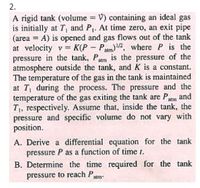
Elements Of Electromagnetics
7th Edition
ISBN: 9780190698614
Author: Sadiku, Matthew N. O.
Publisher: Oxford University Press
expand_more
expand_more
format_list_bulleted
Topic Video
Question

Transcribed Image Text:2.
A rigid tank (volume = V) containing an ideal gas
is initially at T, and P. At time zero, an exit pipe
(area = A) is opened and gas flows out of the tank
at velocity v = K(P – Pam)2, where P is the
pressure in the tank, Patm is the pressure of the
atmosphere outside the tank, and K is a constant.
The temperature of the gas in the tank is maintained
at T, during the process. The pressure and the
temperature of the gas exiting the tank are Patm and
T1, respectively. Assume that, inside the tank, the
pressure and specific volume do not vary with
position.
%3D
A. Derive a differential equation for the tank
pressure P as a function of time t.
B. Determine the time required for the tank
pressure to reach Patm:
Expert Solution
This question has been solved!
Explore an expertly crafted, step-by-step solution for a thorough understanding of key concepts.
This is a popular solution
Trending nowThis is a popular solution!
Step by stepSolved in 6 steps with 8 images

Knowledge Booster
Learn more about
Need a deep-dive on the concept behind this application? Look no further. Learn more about this topic, mechanical-engineering and related others by exploring similar questions and additional content below.Similar questions
- An oil pump operating at steady state delivers oil at a rate of 12 lb/s through a 1-in-diameter exit pipe. The oil, which can be modeled as incompressible, has a density of 70 Ib/ft3 and experiences a pressure rise from inlet to exit of 40 Ib:/in?. There is no significant elevation difference between inlet and exit, and the inlet kinetic energy is negligible. Heat transfer between the pump and its surroundings is negligible, and there is no significant change in temperature as the oil passes through the pump. Determine the velocity of the oil at the exit of the pump, in ft/s, and the power required for the pump, in hp.arrow_forward20 g of air undergoes a closed cycle, illustrated in Figure Q2, which consists of the following 3 processes: 1-2 Constant pressure heat rejection. 2-3 Constant volume heat addition. 3-1 Isothermal expansion back to the original conditions. P (kPa) 75 1 V (m') 0.025 0.04 Figure Q2: Three process cycle Given that Rair = 287 J/kg-K, and Cy = 718 J/kg-K, and assuming ideal gas conditions throughout: (a) Determine the temperatures at points 1, 2 and 3, and the pressure at point 3. (b) Determine the work during each process, and the net work from the cycle. (c) Determine the heat transferred during each process. (d) Verify that this is a cycle.arrow_forwardWhen an ideal gas undergoes isothermal compression as a closed system, its specific internal energy Decreases Does not change O Increasesarrow_forward
- 5. (a) There is 1000 kg water in a swimming pool. Consider the liquid water as an incompressible model at room temperature. If the temperature of the water body is increased by 3 degrees C (assuming this temperature change is uniform across the entire pool), determine: (i) the total internal energy change of the water, (ii) the total enthalpy change of the water. Use a constant heat capacity of water c = 4.211 kJ/kg. K. (b) In a big closed room, there is 1000 kg of air. Suppose the air is an ideal gas model at room temperature. The temperature of the room is increased by 3 degrees C heated by an electric heater. Suppose this temperature change is uniform across the entire room. (iii) Determine the total internal energy change of the air. (iv) Determine the total enthalpy change of the air. Use constant heat capacities of air c₂ = 0.718 kJ/kg . K and Cp = 1.005 kJ/kg.K.arrow_forwardQ. - ome kg of an ideal gas (R = 287 J um irreversible Process from Stelte - 0 [1 bar, 300 k] to State - [2 bar, 300k]. The entropy change (S2-S1) J kg-karrow_forward
arrow_back_ios
arrow_forward_ios
Recommended textbooks for you
 Elements Of ElectromagneticsMechanical EngineeringISBN:9780190698614Author:Sadiku, Matthew N. O.Publisher:Oxford University Press
Elements Of ElectromagneticsMechanical EngineeringISBN:9780190698614Author:Sadiku, Matthew N. O.Publisher:Oxford University Press Mechanics of Materials (10th Edition)Mechanical EngineeringISBN:9780134319650Author:Russell C. HibbelerPublisher:PEARSON
Mechanics of Materials (10th Edition)Mechanical EngineeringISBN:9780134319650Author:Russell C. HibbelerPublisher:PEARSON Thermodynamics: An Engineering ApproachMechanical EngineeringISBN:9781259822674Author:Yunus A. Cengel Dr., Michael A. BolesPublisher:McGraw-Hill Education
Thermodynamics: An Engineering ApproachMechanical EngineeringISBN:9781259822674Author:Yunus A. Cengel Dr., Michael A. BolesPublisher:McGraw-Hill Education Control Systems EngineeringMechanical EngineeringISBN:9781118170519Author:Norman S. NisePublisher:WILEY
Control Systems EngineeringMechanical EngineeringISBN:9781118170519Author:Norman S. NisePublisher:WILEY Mechanics of Materials (MindTap Course List)Mechanical EngineeringISBN:9781337093347Author:Barry J. Goodno, James M. GerePublisher:Cengage Learning
Mechanics of Materials (MindTap Course List)Mechanical EngineeringISBN:9781337093347Author:Barry J. Goodno, James M. GerePublisher:Cengage Learning Engineering Mechanics: StaticsMechanical EngineeringISBN:9781118807330Author:James L. Meriam, L. G. Kraige, J. N. BoltonPublisher:WILEY
Engineering Mechanics: StaticsMechanical EngineeringISBN:9781118807330Author:James L. Meriam, L. G. Kraige, J. N. BoltonPublisher:WILEY

Elements Of Electromagnetics
Mechanical Engineering
ISBN:9780190698614
Author:Sadiku, Matthew N. O.
Publisher:Oxford University Press

Mechanics of Materials (10th Edition)
Mechanical Engineering
ISBN:9780134319650
Author:Russell C. Hibbeler
Publisher:PEARSON

Thermodynamics: An Engineering Approach
Mechanical Engineering
ISBN:9781259822674
Author:Yunus A. Cengel Dr., Michael A. Boles
Publisher:McGraw-Hill Education

Control Systems Engineering
Mechanical Engineering
ISBN:9781118170519
Author:Norman S. Nise
Publisher:WILEY

Mechanics of Materials (MindTap Course List)
Mechanical Engineering
ISBN:9781337093347
Author:Barry J. Goodno, James M. Gere
Publisher:Cengage Learning

Engineering Mechanics: Statics
Mechanical Engineering
ISBN:9781118807330
Author:James L. Meriam, L. G. Kraige, J. N. Bolton
Publisher:WILEY